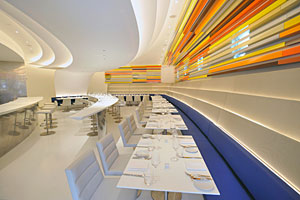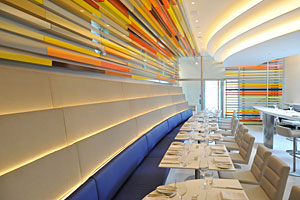

Looking to join such acclaimed museum dining rooms as The Modern at The Museum of Modern Art, and Terzo Piano, atop the Modern Wing of The Art Institute of Chicago, The Wright is the latest destination restaurant with a legacy of art and architecture. Adjacent to the soaring rotunda of Frank Lloyd Wright’s Guggenheim Museum in New York City, The Wright opened this month as part of the iconic building’s 50th anniversary celebration.
Designed with an intelligent sleight of hand by the New York-based Andre Kikoski Architect, the 1,600-sqaure-foot eatery is evocative of its architectural pedigree, yet not overwhelmed by it. According to the firm’s eponymous principal, he and his design team took their cues from Wright’s geometry and materiality, carefully calculating the room’s shapes and proportions based on the motifs and dynamic forms the architect used throughout the structure. Ergo, a crisply stretched ceiling echoes its ribbon-like spirals, as does the softly up-lit tiered wall covered in a sound-absorbing mesh-like textile above the banquette. Sleek Corian horizontal surfaces reference the dynamic planes of its interior.
To further emphasize The Wright’s connection to the museum, the architects maintained a white color palette to provide a gallery-like setting for both the seasonal hues of Chef Rodolfo Contreras cuisine and a recent art acquisition. Prior to construction the Guggenheim commissioned artist Liam Gillick to develop a site-specific installation for the restaurant. Dubbed, “The horizon produced by a factory once it had stopped producing views,” the sculptural piece comprises bold planks of powder-coated aluminum. A fitting gesture, says Kikoski: “Just like the building, the art completes the architecture as much as the architecture complements the art.”

